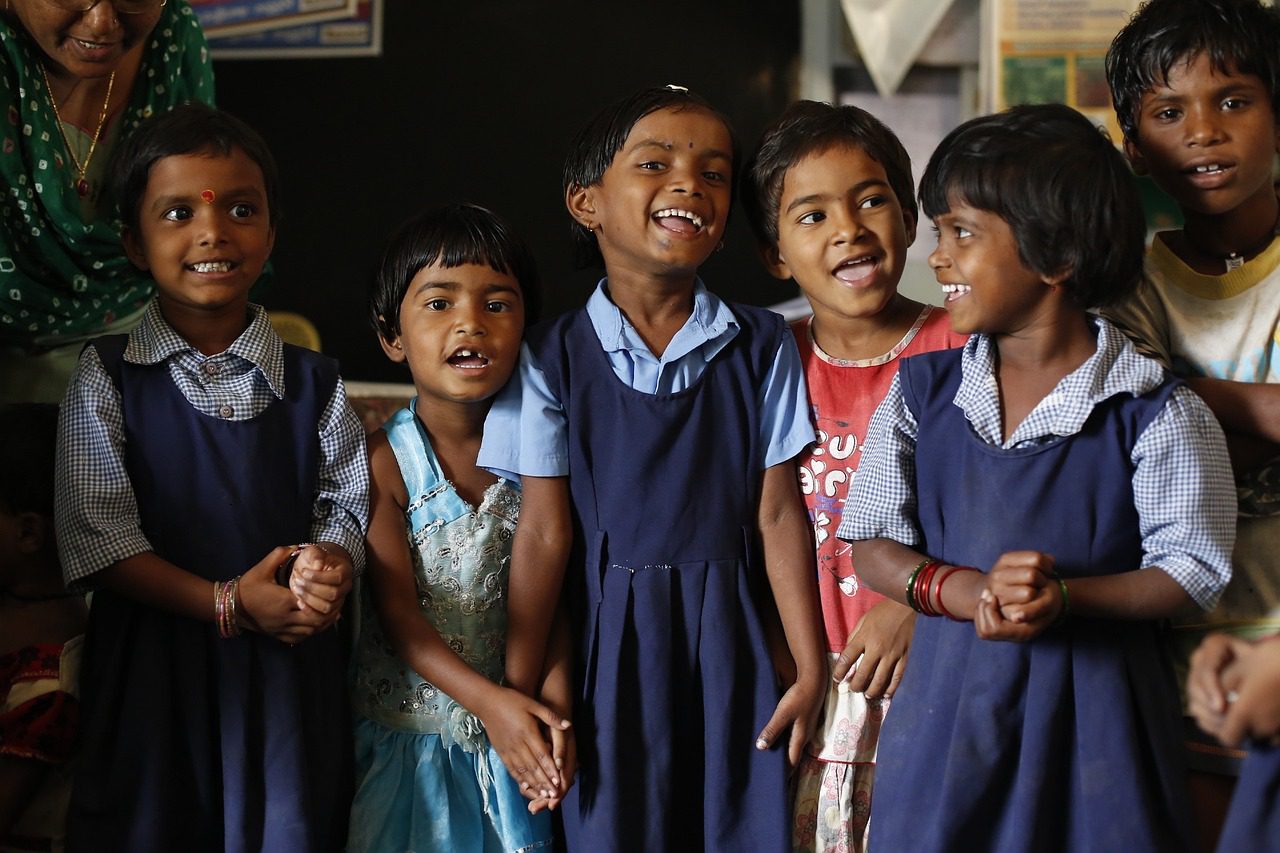
Every child should be afforded the opportunity to attend school and learn the fundamental skills required in life. Education allows children to grow and develop important knowledge in order to strive and succeed in their future lives. Whether a child should have access to this should not be based on his or her gender. Nevertheless, for children living in poverty, it is mostly girls who are deprived of this which leads to gender inequality. According to UNICEF, around the world, 129 million girls are not in school. This includes 32 million girls of primary school age, 30 million girls of lower-secondary school age and 67 million girls of upper-secondary school age.[1] Statistics show that only 49% of countries have an equal number of boys and girls in primary education and this percentage lowers at secondary school level with only 42% of countries having an equal number of boys and girls in lower-secondary education and 24% in upper-secondary education.
In this article, we will firstly look at the reasons as to why girls are prevented from accessing education in many countries worldwide. We will then consider why it is crucial that girls can access education. Lastly, we will explore some of the projects and initiatives set up by charities which aim to help girls access education.
Barriers preventing girls’ education
Poverty
Poverty is one of the main drivers behind girls’ lack of education in many countries around the world. According to the World Bank Group, girls who belong to a family with little income, live in remote locations, have a disability or who are part of a minority ethno-linguistic group are the most behind in terms of accessing and completing education.[2] Families with little income often do not have the money to pay for schools and costs related to schooling such as textbooks, uniforms, transportation and supplies.[3] Therefore, if there are multiple children in a family, boys are usually favoured when it comes to education and girls are asked to help around the house and look after siblings or family members.[4]
Child marriage
Sadly, poverty also results in child marriage which is another reason as to why girls lack education. As stated by Dolores Dixon, Executive Director for Camfed in Canada, “parents who can afford it would not necessarily hold back their children from going to school but if you can’t afford it you will then have to make a choice…they feel [marriage] is the best option within the limited options”.[5] Girls who marry at a young age are less likely to attend school and are more likely to complete less years of education and have children at a young age. The World Bank Group has reported that girls who have been in secondary education are up to six times less likely to marry as girls who have not been educated.[6]
Violence
Girls are often subjected to violence on their way to school and also within schools which prevents them from attending school and dropping out. ActionAid has reported that in the Upper West region of Ghana, girls have to walk long distances to school. More than 50 girls a year are abducted and subjected to sexual violence or sexual exploitation on their way to school.[7] Girls are mostly in danger during the rainy season where attackers hide in the long grass waiting for girls on their way to school.[8]
Girls also face gender-based violence within schools which significantly impacts their physical and mental health and consequently leads to them dropping out of schools. Studies have shown that many schools lack facilities which make them safe such as perimeter fences and well-lit pathways.[9] Nora Fyles, Head of Secretariat for UN Girls’ Education Initiative has stated that “[girls] don’t think about learning when they’re trying to figure out what the next exit is or whether they can go to the toilet and be safe”.[10]
Gender biases in schools
Many practices and facilities within schools are discriminatory towards girls which also results in girls not being able to attend school or dropping out. A lot of schools do not have water, sanitation or hygiene facilities which accommodate girls, for example separate toilets for boys and girls.[11] Marni Sommer, Associate Professor in Sociomedical Sciences at Columbia University, has noted that “[t]here is shame, there’s embarrassment…I’ve been in countries where girls thought if they told anybody [they were menstruating] they’d die”.[12]
Furthermore, in a lot of countries, teaching methods, practices and syllabuses are not gender-neutral which results in gender biases and stereotypes against girls and women.[13] A lot of the time, teachers have not been told how to respond to gender-based violence in schools and do not know how to help girls with issues they have. This leads to girls not feeling comfortable, safe or secure within schools.
Reasons as to why education is important
Breaks poverty cycle
There are several reasons as to why it is as important for girls to access and complete education. Firstly, if girls are educated, they are more likely to attain better paid jobs and earn more money which helps to break the poverty cycle. This in turn creates additional opportunities for girls and women and can contribute to economic growth. According to the Malala Fund, more women in work can add up to $12 trillion to the global economy.[14]
Furthermore, educating girls provides them with core skills which allows them to take up more complex leadership roles such as in politics. This helps them to create effective change, participate in decisions affecting their families and communities, and advocate for future policies.[15] It also reduces the gender gap within jobs and allows everyone to be entitled to the same opportunities.[16]
Reduces child marriage and improves the health of girls
Allowing girls to access education also means that they are less likely to marry at a young age and drop out of school. ActionAid has reported that in 18 out of 20 countries with the highest rates of child marriage, girls who are not in schools are up to six times more likely to marry young than girls who have been educated at secondary level.[17] Educating girls means that they have more control over their lives and will be less likely to suffer from domestic violence.[18]
Additionally, girls who stay in schools are less likely to become pregnant or give birth at a young age which decreases infant and maternal mortality rates.[19] Research has shown that in sub-Saharan Africa, the birth rate among girls who have been educated at secondary level is four times less than girls who have not been educated.[20] Furthermore, well-educated girls are less at risk of contracting HIV and are more likely to utilise methods to prevent diseases such as malaria, for example, by using bed nets.[21]
Helps to prepare for natural disasters
Studies have shown that educating girls is also useful for climate change and preparing for natural disasters. Brookings Institution has reported that girls who are secondary level educated are the most cost-effective and most effective investment against climate change.[22] They have knowledge about how to cope when there is a natural disaster or when there is severe weather due to climate change and as a result, less deaths or injuries occur within families and communities.[23]
Ways to help girls access education

One of the UN’s Sustainable Development Goals is to ‘[e]nsure inclusive and equitable quality education and promote lifelong learning opportunities for all’ by 2030.[24] However, there is a lot to be done in order to reduce gender inequality in schools and allow more girls to access education around the world. Many charities have set up projects and initiatives and some of these are outlined below.
Helping girls get to school safely
As mentioned previously in the article, girls are often at risk of being abducted and are subjected to sexual violence or sexual exploitation whilst making their way to school. Therefore, it is crucial that there are plans to help girls get to school safely. ActionAid have implemented an initiative where they provide bikes to girls which shortens the long and dangerous route to school and means that girls do not have to leave very early in the morning when it is still dark outside.[25]
Eliminating gender inequality in schools
It is also important to remove gender inequality and stereotypes within schools. UNICEF is carrying out work whereby they aim to help governments implement gender-responsive budgets and impose national education policies and plans which promote gender equality. UNICEF is also developing secondary education initiatives which aim to remove discriminatory practices and look at menstrual hygiene practices in schools.[26]
Sponsoring a child
Through many charities such as ActionAid or World Vision Canada you can sponsor a child which helps to tackle poverty and ensures everyone obtains an education.[27] Sponsoring a child can help provide basic necessities to families in poverty. It can also help to pay for school fees, equipment and materials associated with schooling such as textbooks. Additionally, it can help to pay for a school building in the place where the child lives. ActionAid has successful changed girls’ lives in Zanzibar. It has been reported that through sponsorship, a school, nursery and hospital were built and children now have somewhere they can go.[28]
Conclusion
Overall, it is clear that both boys and girls should have the right to education and equal opportunities in life, however, in many countries, girls are prevented from being educated which leads to gender inequality. Barriers include poverty, child marriage, violence and gender biases in schools. Educating girls helps to break the poverty cycle, reduces the number of child marriages and improves the health of girls, and it helps families and communities prepare for natural disasters and climate change. Several charities around the world have implemented initiatives and projects which aim to improve girls’ education. Nevertheless, more work needs to be done in local communities in order for the gender gap in education to be eliminated altogether.
[1]UNICEF, ‘Girls’ education’ <https://www.unicef.org/education/girls-education> accessed 30 September 2021
[2]World Bank Group, ‘Girls’ Education’ <https://www.worldbank.org/en/topic/girlseducation#1> accessed 30 September 2021
[3]ibid
[4]ibid
[5]Laura Paddison, ‘Educating girls: the key to tackling global poverty’ The Guardian (04 October 2017)
[6]World Bank Group ‘Girls’ Education’ (n 2)
[7]ActionAid, ‘Girls’ Education’< https://www.actionaid.org.uk/our-work/womens-rights/girls-education> accessed 30 September 2021
[8]ibid
[9]World Bank Group ‘Girls’ Education’ (n 2)
[10]Laura Paddison, ‘Educating girls: the key to tackling global poverty’ (n 5)
[11]World Bank Group ‘Girls’ Education’ (n 2)
[12]Laura Paddison, ‘Educating girls: the key to tackling global poverty’ (n 5)
[13]UNICEF, ‘Girls’ education’ (n 1)
[14]Malala Fund, ‘Girls’ education’ <https://malala.org/girls-education?sc=header> accessed 30 September 2021
[15]ActionAid, ‘Girls’ Education’ (n 7)
[16]UNICEF, ‘Girls’ education’ (n 1)
[17]ActionAid, ‘Girls’ Education’ (n 7)
[18]Theirworld, ‘Girls’ education’ <https://theirworld.org/explainers/girls-education> accessed 30 September 2021
[19]ActionAid, ‘Girls’ Education’ (n 7)
[20]Theirworld, ‘Girls’ education’ (n 18)
[21]ibid
[22]Malala Fund, ‘Girls’ education’ (n 14)
[23]Theirworld, ‘Girls’ education’ (n 18)
[24]United Nations Department of Economic and Social Affairs, Sustainable Development <https://sdgs.un.org/goals/goal4> accessed 30 September 2021
[25]ActionAid, ‘Girls’ Education’ (n 7)
[26]Leah Rodriguez, ‘7 Obstacles to Girls’ Education and How to Overcome Them’ Global Citizen (24 September 2019)
[27]ActionAid, ‘Girls’ Education’ (n 7) and World Vision Canada, ‘Girls’ education: facts and how to help’ <https://www.worldvision.ca/stories/education/girls-education-facts-and-how-to-help> accessed 30 September 2021
[28]ActionAid, ‘Girls’ Education’ (n 7)


